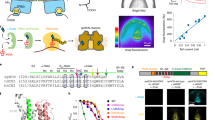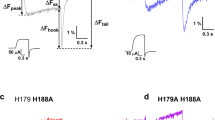Abstract
Voltage-gated ion channels open and close in response to voltage changes across electrically excitable cell membranes1. Voltage-gated potassium (Kv) channels are homotetramers with each subunit constructed from six transmembrane segments, S1–S6 (ref. 2). The voltage-sensing domain (segments S1–S4) contains charged arginine residues on S4 that move across the membrane electric field2,3, modulating channel open probability. Understanding the physical movements of this voltage sensor is of fundamental importance and is the subject of controversy. Recently, the crystal structure of the KvAP4 channel motivated an unconventional ‘paddle model’ of S4 charge movement, indicating that the segments S3b and S4 might move as a unit through the lipid bilayer with a large (15–20-Å) transmembrane displacement5. Here we show that the voltage-sensor segments do not undergo significant transmembrane translation. We tested the movement of these segments in functional Shaker K+ channels by using luminescence resonance energy transfer to measure distances between the voltage sensors and a pore-bound scorpion toxin. Our results are consistent with a 2-Å vertical displacement of S4, not the large excursion predicted by the paddle model. This small movement supports an alternative model in which the protein shapes the electric field profile, focusing it across a narrow region of S4 (ref. 6).
This is a preview of subscription content, access via your institution
Access options
Subscribe to this journal
Receive 51 print issues and online access
$199.00 per year
only $3.90 per issue
Buy this article
- Purchase on Springer Link
- Instant access to full article PDF
Prices may be subject to local taxes which are calculated during checkout




Similar content being viewed by others
References
Hodgkin, A. L. & Huxley, A. F. A quantitative description of membrane current and its application to conduction and excitation in nerve. J. Physiol. (Lond.) 117, 500–544 (1952)
Bezanilla, F. The voltage sensor in voltage-dependent ion channels. Physiol. Rev. 80, 555–592 (2000)
Armstrong, C. M. & Bezanilla, F. Currents related to movement of the gating particles of the sodium channels. Nature 242, 459–461 (1973)
Jiang, Y. et al. X-ray structure of a voltage-dependent K+ channel. Nature 423, 33–41 (2003)
Jiang, Y., Ruta, V., Chen, J., Lee, A. & MacKinnon, R. The principle of gating charge movement in a voltage-dependent K+ channel. Nature 423, 42–48 (2003)
Starace, D. M. & Bezanilla, F. A proton pore in a potassium channel voltage sensor reveals a focused electric field. Nature 427, 548–553 (2004)
Clegg, R. M. Fluorescence resonance energy transfer. Curr. Opin. Biotechnol. 6, 103–110 (1995)
Selvin, P. R. The renaissance in fluorescence resonance energy transfer. Nature Struct. Biol. 7, 730–734 (2000)
Selvin, P. R., Rana, T. M. & Hearst, J. E. Luminescence resonance energy transfer. J. Am. Chem. Soc. 116, 6029–6030 (1994)
Selvin, P. R. Principles and biophysical applications of luminescent lanthanide probes. Annu. Rev. Biophys. Biomol. Struct. 31, 275–302 (2002)
Reifenberger, J. G., Snyder, G. E., Baym, G. & Selvin, P. R. Emission polarization of europium and terbium chelates. J. Phys. Chem. B 107, 12862–12873 (2003)
Cha, A., Snyder, G. E., Selvin, P. R. & Bezanilla, F. Atomic scale movement of the voltage sensing region in a potassium channel measured via spectroscopy. Nature 402, 809–813 (1999)
Glauner, K. S., Mannuzzu, L. M., Gandhi, C. S. & Isacoff, E. Y. Spectroscopic mapping of voltage sensor movement in the Shaker potassium channel. Nature 402, 813–817 (1999)
MacKinnon, R. & Miller, C. Mechanism of charybdotoxin block of the high-conductance, Ca2+-activated K+ channel. J. Gen. Physiol. 91, 335–349 (1988)
Goldstein, S. A. & Miller, C. Mechanism of charybdotoxin block of a voltage-gated K+ channel. Biophys. J. 65, 1613–1619 (1993)
Aggarwal, S. K. & MacKinnon, R. Contribution of the S4 segment to gating charge in the Shaker K+ channel. Neuron 16, 1169–1177 (1996)
Hessa, T., White, S. H. & von Heijne, G. Membrane insertion of a potassium-channel voltage sensor. Science 307, 1427 (2005)
Cuello, L. G., Cortes, D. M. & Perozo, E. Molecular architecture of the KvAP voltage-dependent K+ channel in a lipid bilayer. Science 306, 491–495 (2004)
Baumgartner, W., Islas, L. & Sigworth, F. J. Two-microelectrode voltage clamp of Xenopus oocytes: voltage errors and compensation for local current flow. Biophys. J. 77, 1980–1991 (1999)
Blaustein, R. O., Cole, P. A., Williams, C. & Miller, C. Tethered blockers as molecular ‘tape measures’ for a voltage-gated K+ channel. Nature Struct. Biol. 7, 309–311 (2000)
Laine, M. et al. Atomic proximity between S4 segment and pore domain in Shaker potassium channels. Neuron 39, 467–481 (2003)
Laine, M., Papazian, D. M. & Roux, B. Critical assessment of a proposed model of Shaker. FEBS Lett. 564, 257–263 (2004)
Eriksson, M. A. & Roux, B. Modeling the structure of agitoxin in complex with the Shaker K+ channel: a computational approach based on experimental distance restraints extracted from thermodynamic mutant cycles. Biophys. J. 83, 2595–2609 (2002)
Asamoah, O. K., Wuskell, J. P., Loew, L. M. & Bezanilla, F. A fluorometric approach to local electric field measurements in a voltage-gated ion channel. Neuron 37, 85–97 (2003)
Heyduk, T. & Heyduk, E. Luminescence energy transfer with lanthanide chelates: interpretation of sensitized acceptor decay amplitudes. Anal. Biochem. 289, 60–67 (2001)
Shimony, E., Sun, T., Kolmakova-Partensky, L. & Miller, C. Engineering a uniquely reactive thiol into a cysteine-rich peptide. Protein Eng. 7, 503–507 (1994)
Goldstein, S. A., Pheasant, D. J. & Miller, C. The charybdotoxin receptor of a Shaker K+ channel: peptide and channel residues mediating molecular recognition. Neuron 12, 1377–1388 (1994)
Mannuzzu, L. M., Moronne, M. M. & Isacoff, E. Y. Direct physical measure of conformational rearrangement underlying potassium channel gating. Science 271, 213–216 (1996)
Acknowledgements
We thank B. Roux for putting together coordinates for a combined model of the AgTX–Shaker complex23 with the model for the Shaker open state21, and L. Kolmakova-Partensky and T. Lawrecki for technical assistance. This work was supported by grants from the NIH, NSF, the Carver Foundation and the Cottrell funds of the Research Corp to P.R.S., from an NIH grant to F.P., and from the Howard Hughes Medical Institute to C.M. P.R.S. also thanks J. Ackland, J. Stenehjem and the other members of the Sharp Rehabilitation Center of San Diego for their care, which made this study possible.
Author information
Authors and Affiliations
Corresponding author
Ethics declarations
Competing interests
Reprints and permissions information is available at npg.nature.com/reprintsandpermissions. The authors declare no competing financial interests.
Supplementary information
Supplementary Data
Additional information on this study, including Supplementary Discussion with Supplementary Figures and additional references. (PDF 817 kb)
Rights and permissions
About this article
Cite this article
Posson, D., Ge, P., Miller, C. et al. Small vertical movement of a K+ channel voltage sensor measured with luminescence energy transfer. Nature 436, 848–851 (2005). https://doi.org/10.1038/nature03819
Received:
Accepted:
Issue Date:
DOI: https://doi.org/10.1038/nature03819
This article is cited by
-
Voltage-dependent gating in K channels: experimental results and quantitative models
Pflügers Archiv - European Journal of Physiology (2020)
-
The HCN channel voltage sensor undergoes a large downward motion during hyperpolarization
Nature Structural & Molecular Biology (2019)
Comments
By submitting a comment you agree to abide by our Terms and Community Guidelines. If you find something abusive or that does not comply with our terms or guidelines please flag it as inappropriate.



